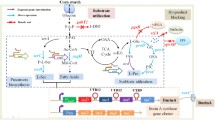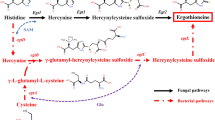Abstract
Acetol, a C3 keto alcohol, is an important intermediate used to produce polyols and acrolein. To enhance acetol production from glycerol by Escherichia coli, a mutant (HJ02) was constructed by replacing the native glpK gene with the allele from E. coli Lin 43 and overexpression of yqhD, which encodes aldehyde oxidoreductase YqhD that converts methylglyoxal to acetol. Compared to the control strain without the glpK replacement, HJ02 had 5.5 times greater acetol production and a 53.4 % higher glycerol consumption rate. Then, glucose was added as a co-substrate to enhance NADPH availability and the ptsG gene was deleted in HJ02 (HJ04) to alleviate carbon catabolite repression, which led to a 30 % increase in the NADPH level and NADPH/NADP+. Consequently, HJ04 accumulated up to 1.20 g/L of acetol, which is 69.0 % higher than that of HJ02. Furthermore, the gapA gene in HJ04 was silenced by antisense RNA (HJ05) to further enhance acetol production. The acetol concentration produced by HJ05 reached 1.82 g/L, which was 2.1 and 1.5 times higher than that of HJ02 and HJ04.
Real-time PCR analysis indicates that glucose catabolism was rerouted from glycolysis to the oxidative pentose phosphate pathway in HJ05.




Similar content being viewed by others
References
Almeida JRM, Fávaro LCL, Quirino BF (2012) Biodiesel biorefinery: opportunities and challenges for microbial production of fuels and chemicals from glycerol waste. Biotechnol Biofuels 5:48. doi:10.1186/1754-6834-5-48
Baba T, Ara T, Hasegawa M, Takai Y, Okumura Y, Baba M, Datsenko KA, Tomita M, Wanner BL, Mori H (2006) Construction of Escherichia coli K-12 in-frame, single-gene knockout mutants: the Keio collection. Mol Syst Biol 2:1–11. doi:10.1038/msb4100050
Booth IR, Ferguson GP, Miller S, Li C, Gunasekera B, Kinghorn S (2003) Bacterial production of methylglyoxal: a survival of strategy or death by misadventure? Biochem Soc Trans 31:1406–1408. doi:10.1042/BST0311406
Cameron DC, Cooney CL (1986) A novel fermentation: the production of R(−)–1, 2–propanediol and acetol by Clostridium thermosaccharolyticum. Nat Biotechnol 4(7):651–654. doi:10.1038/nbt0786-651
Cherepanov P, Wackernagel W (1995) Gene disruption in Escherichia coli: Tc R and Km R cassettes with the option of Flp-catalyzed excision of the antibiotic-resistance determinant. Genes 9:0378–1119. doi:10.1016/0378-1119(95)00193-A
Chin JW, Khankal R, Monroe CA, Maranas CD, Cirino PC (2009) Analysis of NADPH supply during xylitol production by engineered Escherichia coli. Biotechnol Bioeng 102(1):209–220. doi:10.1002/bit.22060
Chubukov V, Uhr M, Le Chat L, Kleijn RJ, Jules M, Link H, Aymerich S, Stelling J, Sauer U (2013) Transcriptional regulation is insufficient to explain substrate-induced flux changes in Bacillus subtilis. Mol Syst Biol 9(1). doi:10.1038/msb.2013.66
Clomburg JM, Gonzalez R (2011) Metabolic engineering of Escherichia coli for the production of 1,2-propanediol from glycerol. Biotechnol Bioeng 108(4):867–879. doi:10.1002/bit.22993
Clomburg JM, Gonzalez R (2013) Anaerobic fermentation of glycerol: a platform for renewable fuels and chemicals. Trends Biotechnol 31(1):20–28. doi:10.1016/j.tibtech.2012.10.006
Cui YY, Ling C, Zhang YY, Huang J, Liu JZ (2014) Production of shikimic acid from Escherichia coli through chemically inducible chromosomal evolution and cofactor metabolic engineering. Microb Cell Factories 13:21. doi:10.1186/1475-2859-13-21
Deutscher J, Francke C, Postma PW (2006) How phosphotransferase system-related protein phosphorylation regulates carbohydrate metabolism in bacteria. Microbiol Mol Biol Rev 70(4):939–1031. doi:10.1128/MMBR.00024-06
Freedberg WB, Kistler WS, Lin ECC (1971) Lethal synthesis of methylglyoxal by Escherichia coli during unregulated glycerol metabolism. J Bacteriol 108(1):137–144
Gosset G (2005) Improvement of Escherichia coli production strains by modification of the phosphoenolpyruvate: sugar phosphotransferase system. Microb Cell Factories 4(1):14. doi:10.1186/1475-2859-4-14
Gottlieb K, Albermann C, Sprenger GA (2014) Improvement of L-phenylalanine production from glycerol by recombinant Escherichia coli strains: the role of extra copies of glpK, glpX, and tktA genes. Microb Cell Factories 13(1):96. doi:10.1186/s12934-014-0096-1
Holtman CK, Thurlkill R, Pettigrew DW (2001) Unexpected presence of defective glpR alleles in various strains of Escherichia coli. J Bacteriol 183(4):1459–1461. doi:10.1128/JB.183.4.1459-1461.2001
Hopper DJ, Cooper RA (1972) The purification and properties of Escherichia coli methylglyoxal synthase. Biochem J 128(2):321–329
Jain R, Sun X, Yuan Q, Yan Y (2014) Systematically engineering Escherichia coli for enhanced production of 1, 2-propanediol and 1-propanol. Biol, ACS Synth. doi:10.1021/sb500345t
Jan J, Martinez I, Wang Y, Bennett GN, San KY (2013) Metabolic engineering and transhydrogenase effects on NADPH availability in Escherichia coli. Biotechnol Prog 29(5):1124–1130. doi:10.1002/btpr.1765
Jarboe LR (2011) YqhD: a broad-substrate range aldehyde reductase with various applications in production of biorenewable fuels and chemicals. Appl Microbiol Biotechnol 89(2):249–257. doi:10.1007/s00253-010-2912-9
Kitagawa M, Ara T, Arifuzzaman M, Ioka-Nakamichi T, Inamoto E, Toyonaga H, Mori H (2005) Complete set of ORF clones of Escherichia coli ASKA library (a complete set of E. coli K-12 ORF archive): unique resources for biological research. DNA Res 12(5):291–299. doi:10.1093/dnares/dsi012
Ko J, Kim I, Yoo S, Min B, Kim K, Park C (2005) Conversion of methylglyoxal to acetol by Escherichia coli aldo-keto reductases. J Bacteriol 187(16):5782–5789. doi:10.1128/jb.187.16.5782-5789.2005
Kruger NJ, von Schaewen A (2003) The oxidative pentose phosphate pathway: structure and organisation. Curr Opin Plant Biol 6(3):236–246. doi:10.1016/S1369-5266(03)00039–6
Lee HC, Kim JS, Jang W, Kim SY (2010) High NADPH/NADP+ ratio improves thymidine production by a metabolically engineered Escherichia coli strain. J Biotechnol 149(1):24–32. doi:10.1016/j.jbiotec.2010.06.011
Lim SJ, Jung YM, Shin HD, Lee YH (2002) Amplification of the NADPH-related genes zwf and gnd for the oddball biosynthesis of PHB in an E. coli transformant harboring a cloned phbCAB operon. J Biosci Bioeng 93(6):543–549 doi:10.1016/S1389-1723(02)80235–3
Lin ECC (1976) Glycerol dissimilation and its regulation in bacteria. Annu Rev Microbiol 30(1):535–578
Marr AG (1991) Growth rate of Escherichia coli. Microbiol Rev 55(2):316–333. doi: 0146–0749/91/020316–18$02.00/0
Martínez K, de Anda R, Hernández G, Escalante A, Gosset G, Ramírez OT, Bolívar FG (2008) Coutilization of glucose and glycerol enhances the production of aromatic compounds in an Escherichia coli strain lacking the phosphoenolpyruvate: carbohydrate phosphotransferase system. Microb Cell Factories 7(1):1. doi:10.1186/1475-2859-7-1
Mazumdar S, Blankschien MD, Clomburg JM, Gonzalez R (2013) Efficient synthesis of L-lactic acid from glycerol by metabolically engineered Escherichia coli. Microb Cell Factories 12(1):7. doi:10.1186/1475-2859-12-7
Mohamad MH, Awang R, Yunus WMZW (2011) A review of acetol: application and production. Am J Appl Sci 8. doi:10.3844/ajassp.2011.1135.1139
Nakashima N, Tamura T (2009) Conditional gene silencing of multiple genes with antisense RNAs and generation of a mutator strain of Escherichia coli. Nucleic Acids Res 37(15):e103. doi:10.1093/nar/gkp498
Pettigrew DW, Ma DP, Conrad CA, Johnson JR (1988) Escherichia coli glycerol kinase: cloning and sequencing of the glpK gene and the primary structure of the enzyme. J Biol Chem 263(5):135–139
Pettigrew DW, Liu WZ, Holmes C, Holmes C, Meadow ND, Roseman S (1996) A single amino acid change in Escherichia coli glycerol kinase abolishes glucose control of glycerol utilization in vivo. J Bacteriol 178(10):2846–2852
Reeves HC, Brehmeyer BA, Ajl SJ (1968) Multiple forms of bacterial NADP-specific isocitrate dehydrogenase. Science 162(3851):359–360. doi:10.1126/science.162.3851.359
Sato S, Akiyama M, Takahashi R, Hara T, Inui K, Yokota M (2008) Vapor-phase reaction of polyols over copper catalysts. Appl Catal A 347(2):186–191. doi:10.1016/j.apcata.2008.06.013
Sauer U, Canonaco F, Heri S, Perrenoud A, Fischer E (2004) The soluble and membrane-bound transhydrogenases UdhA and PntAB have divergent functions in NADPH metabolism of Escherichia coli. J Biol Chem 279(8):6613–6619. doi:10.1074/jbc.M311657200
Seta FD, Boschi-Muller S, Vignais M, Branlant G (1997) Characterization of Escherichia coli strains with gapA and gapB genes deleted. J Bacteriol 179(16):5218–5221. doi: 0021–9193/97/$04.00 + 0
Siedler S, Lindner SN, Bringer S, Wendisch VF, Bott M (2013) Reductive whole-cell biotransformation with Corynebacterium glutamicum: improvement of NADPH generation from glucose by a cyclized pentose phosphate pathway using pfkA and gapA deletion mutants. Appl Microbiol Biotechnol 97(1):143–152. doi:10.1007/s00253-012-4314-7
Soucaille P, Meynial-Salles I, Voelker F, Figge R (2008a) Metabolically engineered microorganisms for production of 1,2-propanediol and acetol. WO 2008/116853
Soucaille P, Voelker F, Figge R (2008b) Metabolically engineered microorganism useful for the production of acetol. WO2008/116851
Wang Z, Yang ST (2013) Propionic acid production in glycerol/glucose co-fermentation by Propionibacterium freudenreichii subsp. shermanii. Bioresour Technol 137(0):116–123. doi:10.1016/j.biortech.2013.03.012
Wong MS, Li M, Black RW, Le TQ, Puthli S, Campbell P, Monticello DJ (2014) Microaerobic conversion of glycerol to ethanol in Escherichia coli. Appl Environ Microbiol 80(10):3276–3282. doi:10.1128/AEM.03863-13
Wu H, Karanjikar M, San KY (2014) Metabolic engineering of Escherichia coli for efficient free fatty acid production from glycerol. Metab Eng 25:82–91. doi:10.1016/j.ymben.2014.06.009
Yamaguchi A, Hiyoshi N, Sato O, Shirai M (2010) Dehydration of triol compounds in high-temperature liquid water under high-pressure carbon dioxide. Top Catal 53(7):487–491. doi:10.1007/s11244-010-9476-x
Yang Y, Yuan C, Dou J, Han X, Wang H, Fang H, Zhou C (2014) Recombinant expression of glpK and glpD genes improves the accumulation of shikimic acid in E. coli grown on glycerol. World J Microbiol Biotechnol 30(12):3263–3272. doi:10.1007/s11274-014-1753-6
Zhu H, Yi X, Liu Y, Hu H, Wood TK, Zhang X (2013) Production of acetol from glycerol using engineered Escherichia coli. Bioresour Technol 149:238–243. doi:10.1016/j.biortech.2013.09.062
Zwaig N, Kistler WS, Lin EC (1970) Glycerol kinase, the pacemaker for the dissimilation of glycerol in Escherichia coli. J Bacteriol 102(3):753–759
Acknowledgments
This study was supported by 973 Programs of China (2012CB721005), the National Natural Science Foundation of China (31400086 and J1210047), and China Postdoctoral Science Foundation (2014M551404). The authors are grateful to Dr. Nakashima at Advanced Industrial Science and Technology (AIST) in Japan for kindly providing the plasmid of pHN1009.
Conflict of interest
The authors declare that they have no competing interests.
Author information
Authors and Affiliations
Corresponding author
Electronic supplementary material
ESM 1.
(PDF 16 kb)
Rights and permissions
About this article
Cite this article
Yao, R., Liu, Q., Hu, H. et al. Metabolic engineering of Escherichia coli to enhance acetol production from glycerol. Appl Microbiol Biotechnol 99, 7945–7952 (2015). https://doi.org/10.1007/s00253-015-6732-9
Received:
Revised:
Accepted:
Published:
Issue Date:
DOI: https://doi.org/10.1007/s00253-015-6732-9




